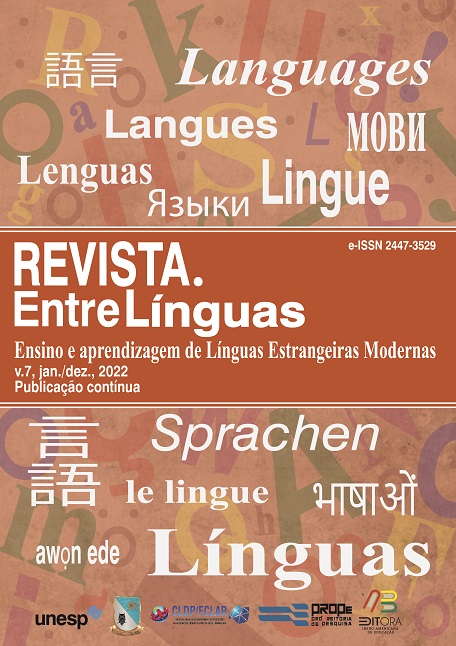Reprodução da modalidade intersemiótica na adaptação cinematográfica do romance "Harry Potter e a Pedra Filosofal"
DOI:
https://doi.org/10.29051/el.v8i00.17592Palavras-chave:
Tradução, Tradução intersemiótica, Modalidade, Adaptação cinematográfica, Harry PotterResumo
O artigo centra-se na formulação da estratégia de reprodução das palavras modais em tradução intersemiótica sobre a adaptação cinematográfica de "Harry Potter e a Pedra Filosofal" de J. K. Rowling. Visa-se, aqui, descrever as estratégias adaptativas da reprodução de palavras modais em tradução intersemiótica durante a adaptação de obra literária, que pode ser expressa em representação, gestos, movimentos e planos. Esta abordagem permite refletir elementos como fenômenos naturais, edifícios, objetos móveis e imóveis. Explorou-se a utilização de estratégias adaptativas nas duas semioses, bem como a modalidade do autor, e apresentou-se a comparação dos diálogos das obras. Foi estabelecido que, nas obras literárias, as palavras modais são frequentemente encontradas nas palavras do autor e nas reflexões dos personagens, ou seja, nos segmentos susceptíveis à corrosão durante tradução intersemiótica. Portanto, a fim de manter intencionalidade autoral, os tradutores recorrem a certas estratégias. Assim, neste artigo, essas estratégias foram identificadas no exemplo estudado.
Downloads
Referências
ALGEO, J. A Comprehensive Grammar of the English Language. By Randolph Quirk, Sidney Greenbaum, Geoffrey Leech, and Jan Svartvik. London: Longman. 1985. x + 1779. Journal of English Linguistics, v. 20, n. 1, p. 122-136, Apr. 1987. DOI: 10.1177/007542428702000108. Available: https://journals.sagepub.com/doi/10.1177/007542428702000108. Access: 2 Apr. 2022.
ANDERSON, S. R. Linguistic expression and its relation to modality. In: ANDERSON, S. R. Current Issues in ASL Phonology. Elsevier, 1993. p. 273-290. ISBN 9780121932701. DOI: 10.1016/B978-0-12-193270-1.50018-2. Available: https://www.sciencedirect.com/science/article/pii/B9780121932701500182?via%3Dihub. Access: 2 Apr. 2022.
BRANCO, S. O.; SANTOS, L. S. O uso de atividades de tradução intersemiótica e interlingual em uma sala de aula de língua inglesa como le. Revista EntreLinguas, Araraquara, v. 3, n. 2, p. 203-226, Dec. 2017. DOI: 10.29051/rel.v3.n2.2017.9229. Available: https://periodicos.fclar.unesp.br/entrelinguas/article/view/9229/6966. Access: 2 Apr. 2022.
CAMERON, D. Language, Gender, and Sexuality: Current Issues and New Directions. Applied Linguistics, v. 26, n. 4, p. 482-502, Dec. 2005. DOI: 10.1093/applin/ami027. Available: https://academic.oup.com/applij/article-abstract/26/4/482/145308?redirectedFrom=fulltext. Access: 2 Apr. 2022 .
HERRING, S.; JOHNSON, D.; DIBENEDETTO, T. Participation in electronic discourse in a “feminist” field. In: COATES, Jennifer; PICHLER, Pia. Language and gender: A reader. 2. ed. Wiley-Blackwell, 2011. p. 171-182 .
HOLUBENKO, N.; DEMETSKAYA, V. Category of Modality Through the Prism of Multipole Approaches in the Modern Translation Theory. Journal of History Culture and Art Research, v. 9, n. 2, p. 303, June 2020. DOI: 10.7596/taksad.v9i2.2500. Available: http://kutaksam.karabuk.edu.tr/index.php/ilk/article/view/2500. Access: 2 Apr. 2022.
JAKOBSON, R. On linguistic aspects of translation. In: On translation. Harvard University Press, 1959. p. 232-239.
KAŹMIERCZAK, M. From Intersemiotic Translation to Intersemiotic Aspects of Translation. Przekładaniec, v. 34-35, p. 7-35, 2018. DOI: 10.4467/16891864epc.18.009.9831. Available: https://www.ejournals.eu/Przekladaniec/English-issues/Special-Issue-Word-and-Image-in-Translation/art/13048/. Access: 2 Apr. 2022.
KEANE, C. How to write a selling screenplay: A step-by-step approach to developing your story and writing your screenplay by one of today's most successful screenwriters and teachers. New York: Broadway Books, 1998. 308 p. ISBN 0767900715.
LIKHODKINA, I. A. (Reflection of literary images in cinema or features of intersemiotic translation. Philological sciences. Questions of theory and practice, v. 3-3, n. 69, p. 128-130, 2017. Available: https://elibrary.ru/item.asp?id=28831784. Access: 2 Apr. 2022.
MONEY, J. Hermaphroditism, gender and precocity in hyperadrenocorticism: Psychologic findings. Bulletin of the Johns Hopkins Hospital, v. 96, n. 6, p. 253-264, 1955 .
NIKONOVA, V.; BOYKO, Y. Gender-specific emotivity of Victorian female prose from a multidimensional perspective. Lege artis. Language yesterday, today, tomorrow, v. 4, n. 1, p. 47-82, 2019 .
NUYTS, Jan. Epistemic modality, language, and conceptualization: A cognitive-pragmatic perspective. John Benjamins Publishing, 2001.
O'BARR, W. M. Linguistic evidence: Language, power, and strategy in the courtroom. Elsevier, 2014 .
ROWLING, J.; KAY, J. Harry Potter and the philosopher's stone. Bloomsbury, 2017.
VOLD, E. T. Epistemic modality markers in research articles: a cross-linguistic and cross-disciplinary study. International Journal of Applied Linguistics, v. 16, n. 1, p. 61-87, Mar. 2006. DOI: 10.1111/j.1473-4192.2006.00106.x. Available: https://onlinelibrary.wiley.com/doi/10.1111/j.1473-4192.2006.00106.x. Access: 2 Apr. 2022.
Downloads
Publicado
Como Citar
Edição
Seção
Licença

Este trabalho está licenciado sob uma licença Creative Commons Attribution-NonCommercial-ShareAlike 4.0 International License.
Os manuscritos aceitos e publicados são de propriedade da Revista EntreLínguas. Os artigos publicados e as referências citadas na Revista EntreLínguas são de inteira responsabilidade de seus autores.
Transferência de direitos autorais – autorização para publicação
Caso o artigo submetido seja aprovado para publicação, já fica acordado que o(s) autor(es) autoriza(m) a UNESP a reproduzi-lo e publicá-lo na EntreLínguas, entendendo-se os termos “reprodução” e “publicação” conforme definição respectivamente dos incisos VI e I do artigo 5° da Lei 9610/98. O artigo poderá ser acessado pela rede mundial de computadores (Internet), sendo permitidas, a título gratuito, a consulta e a reprodução de exemplar do artigo para uso próprio de quem a consulta, desde que haja a citação ao texto consultado. Essa autorização de publicação 328 EntreLínguas, Araraquara, v. 1, n .2, p. 323-328, jul./dez. 2015 não tem limitação de tempo, ficando a UNESP responsável pela manutenção da identificação do(s) autor(es) do artigo. Os artigos publicados e as referências citadas na Revista EntreLínguas são de inteira responsabilidade de seus autores.











